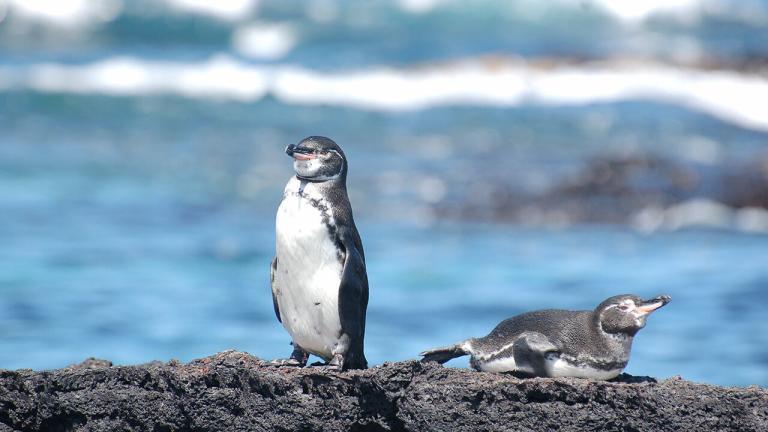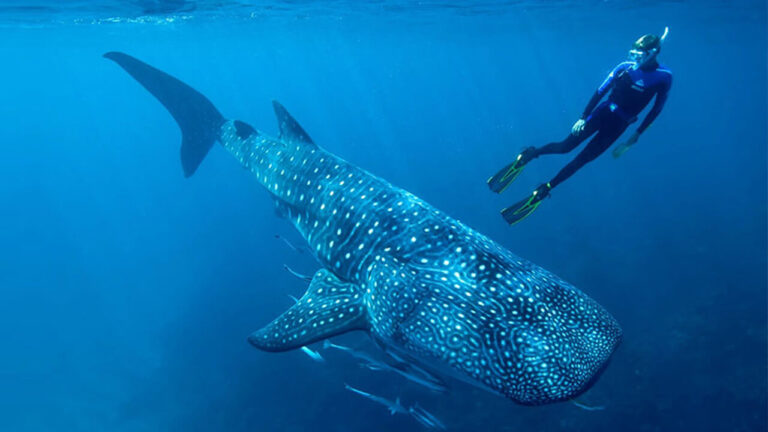The Top 7 Most Interesting Species Found Only in The Galapagos

[:en]What brings travelers to the Galapagos Islands? One of the most common answers is wildlife. While safaris and arctic treks have their appeal, there's no other destination quite like the Galapagos Islands. Species seen nowhere else on earth exist in this one-of-a-kind sea and landscape.[:es]¿Qué trae a los viajeros a las Islas Galápagos? Una de las respuestas más comunes es la vida silvestre. Si bien los safaris y las caminatas árticas tienen su atractivo, no hay otro destino como las Islas Galápagos. Las especies que no se ven en ningún otro lugar de la tierra existen en este mar y paisaje únicos.[:]
[:en]The Galapagos remains the only place to see many unique wildlife wonders due to their isolation from other continents. Plus, there’s no better way to view wildlife than to see them in their natural habitat and behaving in ways that are endlessly entertaining to their audience.
The Most Unique Wildlife in the Galapagos
Although you’ll see a small concentration of species in the Galapagos Islands, there are a few species that are far more unique and endemic. This means that some are only seen in the Galapagos and have adapted to the environment. You may have encounters with dolphins, whales, pelicans, sally lightfoots, sea lions and other more common animals, but some of the Galapagos wildlife that make your trip special are:
- 1: Magnificent frigatebird: The giant red throat of the male magnificent frigatebird is a sight indeed, and one that leaves an impression on travelers. When male frigatebirds are wooing the ladies, they get puffed up in the most eye-catching of ways.
- 2: Galapagos tortoise: The Galapagos tortoises are as iconic as they are big. Most people don’t realize that “galapago” means tortoise in Spanish. Since the islands are devoid of predators, these gentle giants have been able to thrive. Some of them even live well over 100 years. They are highly protected, which is allowing their once dwindling numbers, due to human settlers, to grow once again.
- 3: Waved albatross: The albatross in the Galapagos are the only ones found in the tropics. They also happen to be the largest birds on the islands, and delight people with a sweet “kissing” mating dance.
- 4: Galapagos penguin: This is the only penguin to live north of the equator, and because it does, it’s also the smallest. Like many penguins south of the equator, the Galapagos penguin mates for life.
- 5: Marine iguana: The marine iguana is the only marine lizard in existence because they evolved from land iguanas. They found upon arriving to the Galapagos that their only source of food was underwater, so they underwent an evolutionary process to adapt to their environment and survive. Visitors will delight in its vibrant texture and color, as well as find interest in its backstory. For example, did you know that the marine iguana had special nasal passages that filter salt?
- 6: Galapagos sea lions: Sea lions are a favorite attraction on the Galapagos because they interact and play with people.
- 7: Flightless cormorant: The cormorants in the Galapagos are big, likely due to the fact they can’t fly. They are the only cormorants in the world that have lost the ability to take flight, but that’s definitely a fascination for Audubon members.
Birdwatcher, Underwater Aficionado or Animal Lover: When to Visit
Galapagos animals are abundant, and each time of year features different types of sightings and behaviors. While in general there is no bad time to see Galapagos animals, if you want to see specific types, you may want to research a little deeper to find the best time for you to visit.
Some of the best times to visit are as follows, depending on your interest:
- Birdwatchers: Birdwatchers will benefit year-round. The species are prolific, with everything from the mockingbird and Darwin’s finches to the famous blue-footed booby.
- Snorkelers and Divers: The waters surrounding the islands are full of marine life. According to several dive sources, the best time for serious divers to visit and see more unique sea life throughout the year.
- Animal Lovers: Those who come to see Galapagos animals will find any time of year will do. However, come in August through November to see the sea lion pupping and pups or December to watch the giant tortoises hatch. Other highlights are humpbacks in June and the potential of penguin play during May through September.
The Trip of a Lifetime
Imagine cruising the Galapagos Islands with every day taking you to a different destination. It’s even better when you are hosted by people who know and love everything the islands have to offer visitors, and that can share interesting information about the Galapagos animals.
The Galapagos Islands are the ultimate vacation, where nature is always beautiful, pristine and busy. It is a trip of a lifetime that will stay in your memory long after you’ve returned home.
[:es]Las Galápagos sigue siendo el único lugar para ver muchas maravillas de la vida silvestre debido a su aislamiento de otros continentes. Además, no hay mejor manera de ver la vida silvestre que verla en su hábitat natural, comportándose de manera infinitamente entretenida para su público.
La más única vida silvestre de Galápagos
Las Islas Galápagos tienen una gran concentración de especies, muchas de ellas endémicas y bastante únicas. Esto significa que algunas solo se ven en Galápagos y que se han adaptado al medio ambiente. Puedes tener encuentros con delfines, ballenas, pelícanos, zayapas, lobos marinos y otros animales comunes, pero algunos de los animales de Galápagos que hacen que su viaje sea especial son los siguientes:
- Fragata magnífica: La gigantesca garganta roja de la fragata magnífica macho es un espectáculo que deja huella en los viajeros. Cuando los machos están cortejando a las hembras, se hinchan de la manera más llamativa.
- Tortuga gigante de Galápagos: Las tortugas de Galápagos son tan icónicas como grandes. La mayoría de la gente no sabe que “galápago” significa tortuga en español. Dado que las islas están desprovistas de depredadores, estos amables gigantes han podido prosperar. Algunos de ellos incluso viven más de 100 años. Están altamente protegidos, lo que permite que su número —que antes era cada vez menor debido a los colonos humanos— vuelva a crecer.
- Albatros ondulado: Los albatros ondulados de Galápagos son los únicos que se encuentran en los trópicos. También son las aves más grandes de las islas, y deleitan a la gente con un adorable baile de apareamiento en donde se besan.
- Pingüino de Galápagos: Este es el único pingüino que vive al norte de la línea ecuatorial, y por ello también es el más pequeño. Como muchos pingüinos del sur de la línea ecuatorial, los pingüinos de Galápagos se aparean de por vida.
- Iguana marina: La iguana marina es la única lagartija marina que existe porque evolucionó a partir de las iguanas terrestres. Al llegar a Galápagos descubrieron que su única fuente de alimento estaba bajo el agua, por lo que se sometieron a un proceso evolutivo para adaptarse al medio ambiente y sobrevivir. Los visitantes se deleitarán con su vibrante textura y colorido, así como también encontrarán interés en su historia. Por ejemplo, ¿sabía usted que la iguana marina tiene fosas nasales especiales que filtran la sal?
- Lobos marinos de Galápagos: Los lobos marinos son una de las atracciones favoritas en las islas porque interactúan y juegan con la gente.
- Cormorán no volador: Los cormoranes en Galápagos son grandes, probablemente debido al hecho de que no pueden volar. Son los únicos cormoranes del mundo que han perdido la capacidad de volar, pero eso es definitivamente una fascinación para los miembros de Audubon.
Observador de aves, aficionado submarino o amante de los animales: Cuándo visitar
Los animales de Galápagos son abundantes, y cada época del año presenta diferentes tipos de avistamientos y comportamientos. Aunque en general no existe una mala época para ver animales en Galápagos, si deseas ver tipos específicos, lo mejor es investigar un poco para encontrar el mejor momento para visitar.
Algunos de los mejores momentos para visitar son los siguientes, dependiendo de su interés:
- Observadores de aves: Los observadores de aves se beneficiarán durante todo el año. Las especies son prolíficas: desde el ruiseñor y los pinzones de Darwin hasta el famoso piquero de patas azules.
Amantes de los animales: Aquellos que vienen a ver los animales de Galápagos se darán cuenta de que cualquier momento del año es adecuado. Sin embargo, puedes venir desde agosto hasta noviembre para ver dar a luz a los lobos marinos, o en diciembre para ver incubar a las tortugas gigantes. Otras fechas destacadas comprenden junio para observar a las ballenas jorobadas, y de mayo a septiembre para potencialmente admirar el juego de los pingüinos.
- Snorkelistas y buzos: Las aguas que rodean las islas están llenas de vida marina durante todo el año. Según varias fuentes de buceo, no hay un momento específico que sea mejor para que los buceadores serios visiten y observen esta vida marina única.
El viaje de la vida
Imagina navegar por las Islas Galápagos con un destino diferente cada día. Aun mejor cuando eres hospedado por gente que sabe y ama todo lo que las islas tienen para ofrecer a los visitantes, y que puede compartir información interesante sobre los animales de Galápagos.
Las Islas Galápagos son las vacaciones definitivas, donde la naturaleza es siempre hermosa, prístina y ocupada. Es el viaje de tu vida que permanecerá en la memoria mucho tiempo después de que hayas regresado a casa.[:]




